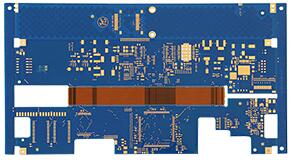1. The circuit board is mainly composed of pads, vias, mounting holes, wires, components, connectors, filling, electrical boundaries, etc. The main functions of each component are as follows: Pad: used to weld the metal of the component pins hole. Vias: There are metal vias and non-metal vias. Metal vias are used to connect component pins between layers. Mounting hole: used to fix the circuit board. Wire: The copper film of the electrical network used to connect the pins of the components. Connectors: components used to connect between circuit boards. Filling: Copper coating for the ground wire network, which can effectively reduce the impedance. Electrical boundary: used to determine the size of the circuit board, all components on the circuit board cannot exceed the boundary.
Main classification
We just mentioned it, so we call this kind of PCB a single-sided. Because single-sided boards have many strict restrictions on the design of the circuit (because there is only one side, the wiring can not be crossed and must be around a separate path), so only early circuits use this type of board.
This kind of circuit board has wiring on both sides. However, to use wires on both sides, there must be a proper circuit connection between the two sides. This kind of "bridge" between circuits is called a via. A via is a small hole filled or coated with metal on the PCB, which can be connected with the wires on both sides. Because the area of the double panel is twice as large as that of the single panel, and because the wiring can be interleaved (it can be wound to the other side), it is more suitable for use than the single panel.

2, the guarantee factor of the reliability of the software and hardware combination version
Secondly, the process of drilling and milling, lamination, pattern production, and pore plating process of the rigid-flex joint zone should be adjusted and optimized to make the flexible zone and the rigid zone be well combined without defects such as layered voids, and the reliability meets the requirements. The main key technologies of rigid-flex board include:
(1) Material matching technology: Rigid-flex board involves the matching of flexible substrates, rigid FR-4 substrates, non-flowing prepregs, cover films and other materials. Material selection is related to the processability and reliability of the product.
(2) Multi-material interlayer alignment and mixed pressure technology: Rigid-flex board has a variety of phases in a longitudinal section. To achieve good interlayer alignment accuracy and bonding strength, in addition to material selection, flexibility The prevention and control of expansion and shrinkage of the board and the rigid board substrate, the positioning method between layers, the design of the laminated structure, and the pre-treatment and pressing process parameters are very important, and multiple sets of process tests are required to explore.
(3) Multi-layer interconnection technology: Rigid-flex boards may have designs such as multilayer interconnection, any layer of buried blind via interconnection, etc., involving key technologies such as drilling of different phases and hole metallization technology, which need to pass the process Research and development to ensure a good combination between the plated hole wall and the inner hole ring to achieve good interlayer interconnection.
(4) Flexible board damage prevention technology: Use the existing conventional hard board production conditions to manufacture rigid-flex board, how to protect the flexible board area from various chemical attacks and mechanical external forces in the process to ensure the appearance quality of the flexible board area, Flexural resistance requirements, insulation reliability requirements, will be the key to the reliability of rigid-flex board.